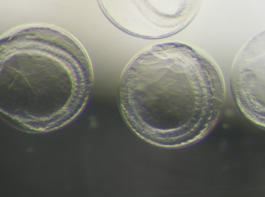Phosichthyidae: D III A1
Vinciguerria nimbaria (Jordan & Williams 1896)
Lightfish




Egg diameter in µm |
Number of oil globules |
Diameter of oil globule in µm |
Yolk texture |
Perivitelline space |
Position of oil globule at hatch |
Gut length at eye- pigment stage |
Myomeres |
625-720 |
0 |
n/a |
segmented |
narrow |
n/a |
76% of NL |
ca44 |
Egg: The small size, coarse yolk segmentation, and lack of an oil globule (A), set this egg apart from all others found in the area, except for DIIIA3, a callionymid. The egg hatched in less than 26 hours (23°C).
Larva: The newly hatched larva is elongate, with a series of black pigment dots dorsally along the notochord, and less conspicuous, ventrally (B). All these move to the ventral edge of the notochord by day 4 (C), when eye pigment and a functional mouth are present. B: newly hatched, C: 4 days.
No attempt was made to rear this egg. Its predominance in offshore samples at Park Rynie, led to this egg becoming a signal of offshore water, when seen in inshore samples. Thirteen larvae hatched from this egg, have been barcoded, and cluster as two different species, with a 5 and 8 split, but no adults have been barcoded (BOLD). Three larvae collected in plankton samples off Park Rynie, fitting the description of V. nimbaria (Ahlstrom & Counts, 1958) have provided a match, but again, have confirmed two species.



This is one of the more common eggs in Park Rynie samples (Introductory notes: Section 7, Table 3). They were seen all year round off Park Rynie (blue graph), and, surprisingly, were seen in the DHM samples on three occasions (green graph). It has showed a progressive drop in occurrence off Park Rynie over the period of the study (white graph). The Park Rynie linked samples had 85% offshore, indicating spawning outside the 50m depth contour, about the same distance offshore where Atractoscion aequidens spawn. See Section 7.3 and Table 1 of the Introductory Notes, for more information on the linked samples.
Linked samples |
Offshore |
Inshore |
Eggs |
433 |
77 |
Hits |
90 |
27 |